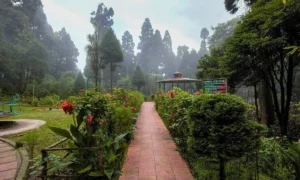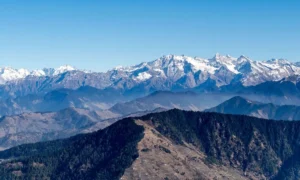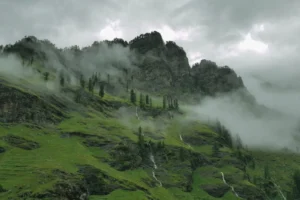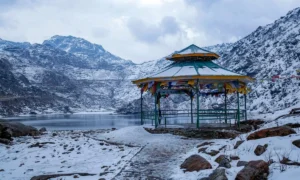Have you ever seen a picture of a breathtaking lake nestled between towering, snow-capped mountains and wondered if such a place truly exists? Perhaps you have heard about a magical lake in Sikkim that changes colors with the seasons and freezes over in winter. Many people are curious about how to visit this stunning destination, or they worry about getting the necessary permits. If you are dreaming of a trip to this natural wonder, you are thinking of Tsomgo Lake, a beautiful glacial lake also known as Changu Lake. It is one of the most popular and celebrated tourist destinations in the entire state of Sikkim, and for good reason. This guide is here to answer all your questions and make your visit as smooth and wonderful as possible. We will explain how to get there, what to expect, and share some insider tips to help you prepare for a truly unforgettable experience.
Tsomgo Lake is not just a body of water; it is a sacred place for the local people and a feast for the eyes of every traveler. The name “Tsomgo” translates to “source of the lake” in the local Bhutia language. Located at a remarkable altitude of over 12,000 feet, the lake is a true marvel of nature. Its surface reflects the surrounding hills and changing sky, offering a new view every time you look. Whether you are interested in the natural beauty, the cultural significance, or the adventure of reaching such a high altitude, this article will provide you with all the valuable, actionable information you need for your journey to Tsomgo Lake.
Exploring the Enchantment of Tsomgo Lake
Tsomgo Lake is a major attraction for visitors to Sikkim, and its beauty changes with the seasons. It is a place of deep cultural significance and natural splendor, offering a unique experience for everyone. Here is a closer look at what makes this glacial lake so special.
The Journey to Tsomgo Lake
The lake is located approximately 38 kilometers from Gangtok, the capital of Sikkim. The journey is an adventure in itself, with the road winding through beautiful mountain terrain.
- A Scenic Drive: The road from Gangtok to Tsomgo Lake is part of the Jawaharlal Nehru Road, a route that eventually leads to the famous Nathula Pass. As you ascend, the landscape transforms from lush greenery to a more rugged, high-altitude environment. You will see towering peaks, deep valleys, and beautiful waterfalls along the way.
- Altitude and Weather: The altitude rises rapidly, so it is wise to go at a slow and steady pace. The weather can be very cold, even in summer, so dressing in layers is important. This gradual increase in altitude is also important to help your body adjust and prevent altitude sickness.
What to See and Do at the Lake
When you arrive at Tsomgo Lake, there is a variety of activities and sights to enjoy. The lake is considered sacred by the locals, who believe that its color changes with the seasons and can predict the future.
- Yak and Mule Rides: One of the most popular activities is riding a yak or mule. The animals are beautifully decorated with colorful woolens and bells, and a ride around the lake shore provides a unique and fun experience. The local yak owners are very friendly and happy to pose for pictures.
- Spectacular Views: The lake is surrounded by steep hills, and the reflection of the mountains on the water is simply stunning. It is a fantastic spot for photography. In the winter, the lake freezes over, and the entire landscape is covered in snow, creating a breathtaking winter wonderland. In spring, the surrounding hills are covered with blooming rhododendrons, a sight to behold.
- Shopping and Food: There are small shops and stalls near the lake where you can buy souvenirs, warm clothes, and enjoy hot tea, coffee, and delicious snacks like instant noodles. These little shops provide a much-needed warmth and comfort in the cold weather.
The Importance of Permits
Visiting Tsomgo Lake requires a special Protected Area Permit (PAP) due to its proximity to the international border. It is a crucial step in planning your trip.
- Who Needs a Permit? All Indian nationals require a permit. Foreigners are also allowed, but the process may be slightly different.
- How to Obtain the Permit: You cannot get the permit on your own. It must be arranged through a registered tour operator or travel agency. You will need to provide a government-approved photo ID (like an Aadhar card or voter ID) and two passport-size photos. The agency will complete the necessary paperwork for you.
- Permit Checkpoints: There are checkpoints along the road where your permit will be verified. It is essential to have all your documents in order.
A study conducted by the Sikkim Tourism Department highlights that the permit system is in place to regulate the number of visitors and ensure the preservation of the delicate ecosystem of the area. Following this process helps protect the natural beauty of the region for future generations.
Best Time to Visit Tsomgo Lake
The beauty of Tsomgo Lake changes with the seasons, so the “best” time to visit depends on what you want to experience.
| Season | Months | What to Expect |
| Spring | March to May | Pleasant weather, clear views, blooming rhododendrons. The lake begins to thaw, and colors are vibrant. |
| Summer/Monsoon | June to August | Frequent rain, landslides are possible. Views can be blocked by clouds and fog. |
| Autumn | September to November | Clear skies, excellent visibility, and pleasant, crisp weather. This is considered the best time for photography. |
| Winter | December to February | The lake freezes over completely. The surrounding landscape is covered in snow. It is very cold, so heavy woolens are a must. |
Important Note: During winter, the road to Tsomgo Lake may be closed due to heavy snowfall. Always check with your tour operator or local sources for the most up-to-date road conditions.
FAQs (Frequently Asked Questions)
Q1. Do I need to book a tour in advance to visit Tsomgo Lake?
Yes, it is highly recommended that you book your tour and permit in advance through a registered tour operator. This simplifies the process and ensures a smooth trip, as you cannot get a permit on the spot.
Q2. Can I visit Nathula Pass and Tsomgo Lake on the same day?
Yes, Tsomgo Lake is on the way to Nathula Pass. Most tour packages include both destinations in a single day trip from Gangtok. It is a very popular combination tour.
Q3. How high is Tsomgo Lake and what should I be aware of?
Tsomgo Lake is located at an altitude of approximately 12,310 feet (3,753 meters). Due to the high altitude, it is wise to move slowly and be aware of symptoms of altitude sickness, such as headache or nausea.
Q4. Is there an entry fee for the lake?
There is no specific entry fee for Tsomgo Lake itself. The cost is included in the tour package provided by your travel agency, which covers the permit, vehicle, and driver.
Conclusion
Tsomgo Lake, or Changu Lake, is a truly spectacular destination that showcases the pristine natural beauty of the Himalayas. We have explored the journey to this sacred lake, the wonderful activities available there, and the essential details regarding permits. By understanding the importance of booking through a tour operator and preparing for the high altitude, you can ensure your trip is a memorable and smooth one. The serene atmosphere and breathtaking views make every effort worthwhile. We hope this guide inspires you to visit this incredible place and witness its magic for yourself. If you have any more questions or have a story to share about your own Tsomgo Lake experience, please leave a comment below!



